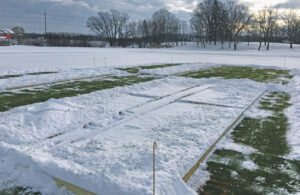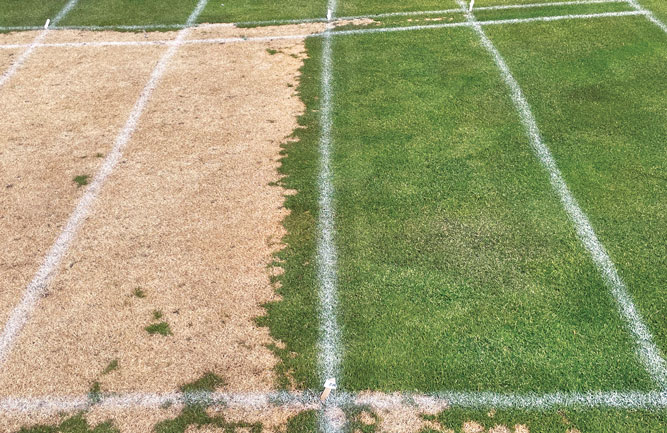What the future looks like for snow mold management
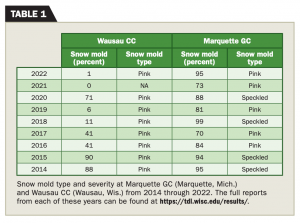
Snow mold type and severity at Marquette GC (Marquette, Mich.) and Wausau CC (Wausau, Wis.) from 2014 through 2022. The full reports from each of these years can be found at https://tdl.wisc.edu/results/.
I am often asked what impacts I think warming winters associated with climate change will have on snow mold management. The easy answer might be that warmer winters will result in less snow, which means less snow mold. But, the more accurate answer is complicated.
Shorter durations of snow cover typically mean less disease, but more winter rainfall events lead to more rapid dissipation of snow mold fungicides. In addition, warmer fall temperatures mean less hardening of the turf prior to winter, which leaves the turf more susceptible to snow mold development. In short, the only certainty that climate change provides for snow mold control is more uncertainty.
What does the research say?
We have been fortunate enough to conduct snow mold research at numerous sites across Wisconsin, Michigan, Minnesota and Idaho. Since the fall of 2013, we have tested at the same locations at Marquette Golf Club in Marquette, Mich., and at Wausau Country Club in Wausau, Wis., every year, which provides us some insight into how snow mold is evolving over a relatively short time.
Wausau Country Club is located in the heart of Wisconsin amid towering pines along the Wisconsin River. Beginning in the spring of 2014 and going through the spring of 2017, snow mold in the non-treated controls averaged 65 percent (Table 1). However, beginning in 2018 and going through 2022, the percent of snow mold in the non-treated controls averaged 18 percent. A large amount of snow mold in 2020 inflates that low number. Looking at just this nine-year period, the data from Wausau suggests that certain locations will experience less snow mold, though they are still prone to significant outbreaks from time to time.
Marquette Golf Club, located in Marquette, Mich., sits along the shores of Lake Superior in the Upper Peninsula of Michigan. Its northern location and proximity to the lake mean that it receives loads of snow every winter and, as a result, typically deals with loads of snow mold. In looking at our disease data over the past nine years from Marquette, it’s clear that the overall amount of snow mold isn’t decreasing.
From 2014 through 2017, the non-treated controls averaged 86 percent snow mold, while from 2018 through 2022, the non-treated controls averaged 87 percent (Table 1). However, the type of snow mold present does appear to shift.
From 2014 through 2018, speckled snow mold (Typhula ishikariensis) was the primary snow mold present in 3 of 5 winters. From 2019 through 2022, pink snow mold (Microdochium nivale) was the primary snow mold present in three of the four winters. One location over a relatively brief nine years is too small of a sample to make any definitive conclusions. Still, I’ve had conversations with superintendents from the Mountain West who have also noticed increasing levels of pink snow mold in areas formerly dominated by gray and speckled snow mold (learn more about preventing gray snow mold here).
How do these shifts impact snow mold management?
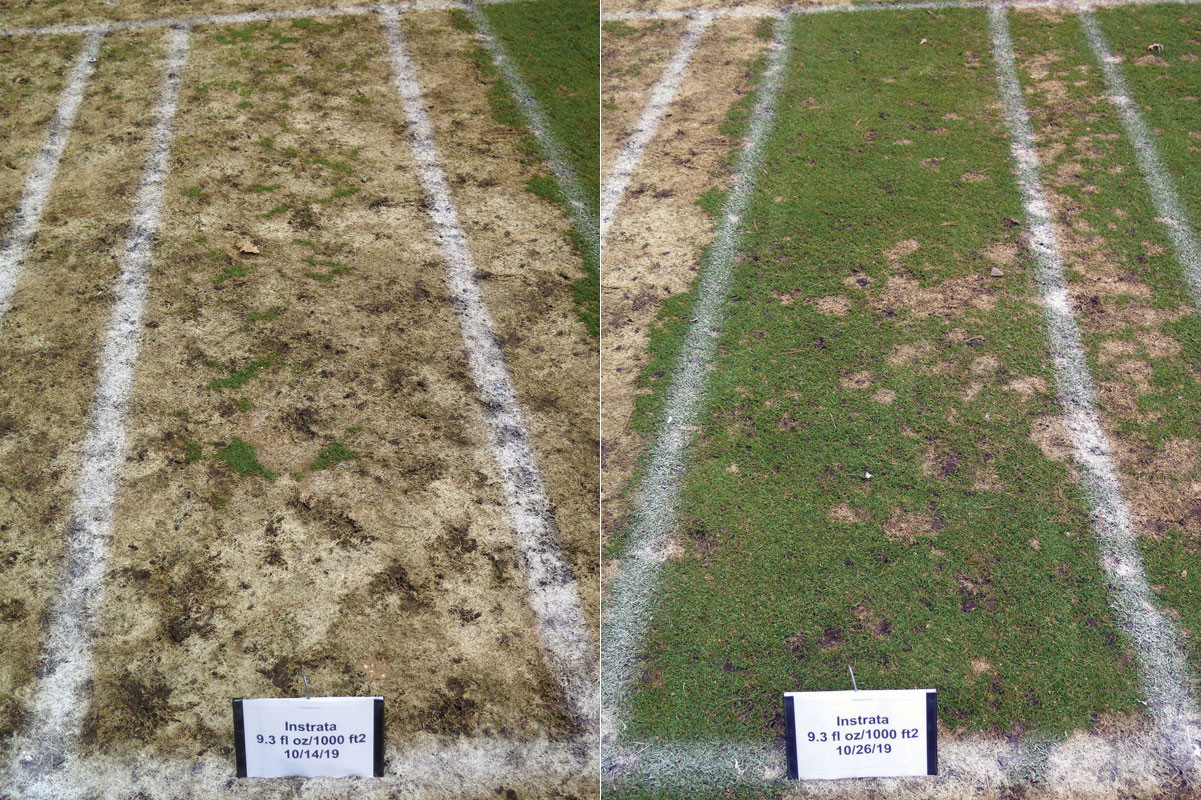
Figure 1. The cutoff between no snow mold suppression and excellent suppression can be very sharp, as evidenced by this picture from Timber Ridge GC in Minocqua, Wis., in the spring of 2020. (Photo: Paul Koch)
From a biological standpoint, the fungus that causes pink snow mold is much faster growing and grows at a wider range of temperatures than the fungi that cause gray and speckled snow mold. This means that pink snow mold is more likely to take advantage of rapid swings in temperature and moisture, whereas the slow-growing Typhula fungi need months of nearly constant conditions to cause disease. This also means that in winters where snow mold fungicide applications degrade due to winter rainfall or snowmelt events, pink snow mold is the disease most likely to take advantage of the lack of plant protection.
From a product selection standpoint, certain chemistries are more effective against pink snow mold than gray and speckled snow mold. While products from the demethylation inhibitor (DMI) class are key for control of gray and speckled snow mold, chemistries such as iprodione, fludioxonil, prothioconazole and thiophanate-methyl are important for effective control of pink snow mold. If you’re starting to see pink snow mold breakthrough, consider looking at the product(s) you’re using and include one or more of the above products in your application.
From an application timing standpoint, don’t apply a product based purely on the calendar. Gayle Worf, Ph.D., was the University of Wisconsin turfgrass pathologist in the ’70s and early ’80s. He always told Wisconsin superintendents to have their snow mold product down prior to getting in the deer stand (i.e., the weekend before Thanksgiving). While that was effective advice then, today’s warmer falls and later start to winter might not make that advice effective now.
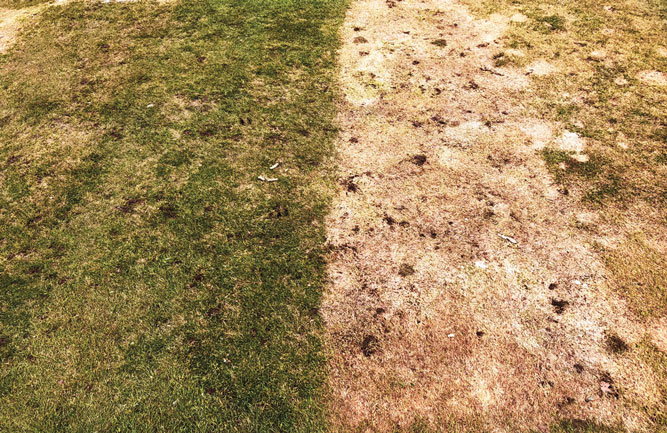
Figure 2. Check plots — whether on the course or the research plot (like this one) — are an excellent tool to better understand your past, current and future snow mold pressure. (Photo: Paul Koch)
My program has been working since 2016 to create a model that would predict the optimal timing of snow mold fungicides based on the local environmental conditions that fall. While we need to conduct some additional research before publicly releasing this model, the data we have so far clearly indicates that the timing of snow mold products is critically important for success.
Our research suggests a window of opportunity for snow mold control that is approximately 3-4 weeks long leading up to snow cover, and the decline in control at the front end of that window is very sharp. In our 2019-20 research, a difference of just 12 days in the application made the difference between a very effective application and failed application (Figure 1). We hope to have more information to share on this model in the next couple of years.
Should you change your snow mold program?
In my experience, superintendents are more resistant to changing their snow mold control program than any other disease control program they have. I understand the hesitancy to try new programs. With snow mold, you usually only have one shot to get it right. But as products and regulations and the environment change, we might also need to update our programs to see whether there is a better fit.
The best way to investigate this on your own site is to install one or more non-treated check plots around the property. The benefits of check plots are numerous. If littered with disease, these plots illustrate to the golfers/membership/ownership the need for implementing these costly disease management programs (Figure 2). If they aren’t littered with disease, and this holds true for several years, then it might indicate that you could alter your program without any decrease in disease control.
It’s also important to keep up with the latest research! My program posts the results of our snow mold research on our Turfgrass Diagnostic Lab research webpage. This research includes product evaluations to find the best products for all types of snow mold under all conditions, but also our research on the development of the snow mold timing model and other related projects. I encourage you to visit the site and look at the research results to understand the most effective products and strategies for controlling snow mold. If you have any questions, please email me at plkoch@wisc.edu.











